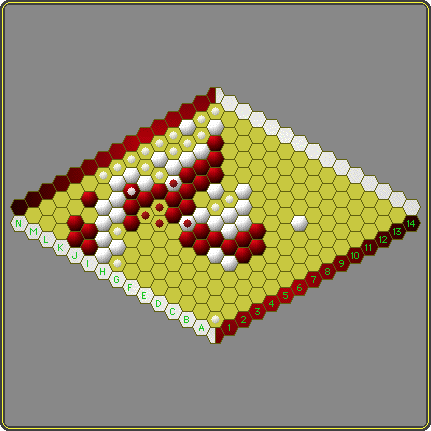 |
Lox has a long lineage. At its basis lies the game of Hex, nowadays commonly attributed to Piet Hein although some believe the claim of an independent discovery by John Forbes Nash. Play Lox interactively How we invented ... Lox |
I'm no expert in Hex variants. The game of Y may be considered a simplification and there are many square games that have the same object, but these must all deal with the diagonal cross cut problem and that as a rule results in more complex rules.
Hex itself combines fundamental simplicity with an enigmatic depth that doesn't really invite the design of variants. But as it happened, I had just made one called KnightVision. In that game I introduced a placement protocol based on the hexagonal knight's jump for reasons that are better explained in Sight Lines and Knight Spots than in an 'About' about Lox.
It's time to turn to Mike Zapawa's Tumbleweed once more, because not only did I arrive at KnightVision via Cannons & Bullets which was based on Tumbleweed's Line of Sight protocol, the other leg of Lox, the game of Stigmergy, invented by Luis Bolaños Mures and Steven Metzger, is a direct descendant of Tumbleweed. It employs sight lines to obtain 'control' of cells and uses this for an embedded form of capture. I was (and am) very enthusiastic about the game.
The step from Cannons & Bullets to KnightVision was in part based on the realisation that the growth and capture mechanism of the former would lend itself better for a connection game. In C&B you can pretty much shoot advantageously in about every direction, but in a connection game, where ownership of a single cell may determine win or loss, it requires shooting at specific cells. The same thought occured to me with regard to Stigmergy: why not use the embedded capture mechanism in a connection game like Hex? So I suggested it to Luis and we decided to make it a co-invention with Stigmergy's co-inventor Steven Metzger.
That's how Lox got its long lineage that includes Piet Hein, John Forbes Nash and Mike Zapawa.
Rules
 |
Definitions
|
The game starts on an empty board. Players move in turn to place one stone on an empty cell not controlled by the opponent, or to replace an opponent's stone by a friendly one on a cell they control. Red moves first. The second player is on his first move entitled to a swap.
If a player on his turn finds a solid cell to cell connection with his pieces between the two edges of his colour, then he has won. It means that any connection made, must outlive the opponent's next turn, a turn in which he can still break it by capture.
Lox © Luis Bolaños Mures, Steven Metzger & MindSports
